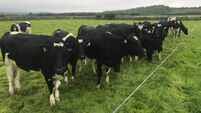Trial results bring promise, but grain prices drag down Darren's returns

Darren Allen in the orchard, which is in full bloom at Ballymaloe Organic Farm, Shanagarry, East Cork. Picture: Dan Linehan
This year’s harvest brought a mixed bag of results. While crop quality was exceptional and yields were respectable, the financial return was deeply disappointing.
Like many in the sector, I’ve come away from the year feeling disheartened — the effort, innovation, and hours put in simply weren’t reflected in the profit margin.
The dry growing season actually suited my heavier land very well. Crops showed minimal signs of drought stress and held up well right through the season.
As many who attended the farm walk in June found out, I’m constantly trialling different and better ways to grow my crops. One of the more successful trials this year was home-melted urea, which I rolled out across a good portion of the farm.
I’ve been experimenting with foliar feeding, combining the urea solution with natural carbon sources like seaweed and molasses. A typical mix included 1.5t of urea in 400 litres of collected rainwater, giving an N17 formulation which I apply at 50 liquid tonnes /ha.
This was applied with each pass into the field, including during fungicide applications. The results were promising. By keeping control plots, I confirmed a noticeable improvement in crop health and was able to reduce nitrogen usage by roughly a third, without sacrificing yield.
It also seemed to reduce the need for fungicides — something I’m keen to explore further, but still learning about it and a work in progress!
Sulphur application also increased this year through the use of gypsum and polysulphate. Phosphate needs were largely met through imported slurry applications, helping to curb my chemical fertiliser bill.
Oats performed consistently, yielding 3.1t/ac dried. Straw was chopped and followed by a cover crop. The crop looked very well all year, on 124 kg N/ha — a combination of TerraCan and home-melted urea.
The pea/bean combi-crop yielded 1.8t/ac, which I considered a strong result given parts of the field were poor from compaction and weather conditions in the previous crop.
The crop was established using strip-till, which I was pleased with. The idea was that the beans would hold up the peas for easy harvest, which proved to be successful.
The winter wheat yield was 4 t/ac dried, but it didn’t start well. Slugs hammered the first sowing after oilseed rape, so I had to replant. Even with reduced fungicide (no T3), it came in clean. Some loads hit 80kph, which was great. I baled the straw for our biomass boiler, which heats the hotel and accommodation — nice to close that loop.
Those who attended the open day saw that I grew high and low input malting barley. The high input was conventionally established using a plough & one-pass, with protected urea as the nitrogen source to a total of 137kg N/ha. Breakeven yield would have been 2.6t/ac, and it yielded 3t/ac.
The low input was established by min-till, with a total nitrogen application of 116kg N/ha, mainly sourced by TerraCan and foliar urea. Breakeven yield for this was 1.8t, and the estimated yield is 3t/ac, similar to the conventional system.
I’m not sure whether this is due to soil health, or organic manure applications or how kind of growing year 2025 was. I don’t think I am ready to do it at a whole field level just yet!
But I’m very happy with the results from my trials. When grain prices are so low, I find it of the utmost importance to curb input costs.
With the early harvest, we planted a wide range of catch crops through both ACRES and the Farming for Water EIP. These are growing strongly and will provide excellent cover to prevent nitrogen leaching to the groundwater, while keeping the soil alive.












